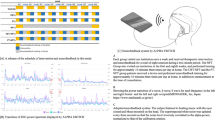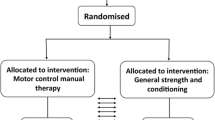Abstract
The application of single motor unit biofeedback training (SMUBT) techniques was compared to traditional therapies in treating chronic low back pain (CLBP). Thirty-six volunteers (who experienced daily pain for 7 years in the T8 to S1 area) were randomly assigned to one of three treatments; SMUBT, relaxation training, or an educational program. The pain level and electromyographic activity of all subjects were assessed by a person blind to the treatment; before, immediately after, and 90 days after treatment. The SMUBT group reported immediately decreased pain which was maintained at 90 days, the relaxation group showed no changes, while the education group reported decreased pain at 90 days. The EMG results showed decreased amplitude and bilateral differences for the SMUBT and education groups. A 4-year follow-up revealed the SMUBT group remained symptom free. Implications and discussion of the results concludes the paper.
Similar content being viewed by others
References
Basmajian JV. Research foundations of EMG biofeedback in rehabilitation.Biofeedback Self-Regulation 1988; 13(4): 275–298.
Yates AJ.Biofeedback and the modification of behavior. New York: Plenum, 1980.
Basmajian JV. Control and training of individual motor units. In: Peper E, Ancoli S, Quinn M, eds.Mind/body integration: Essential readings in biofeedback. New York: Plenum, 1979, pp. 371–375.
Basmajian JV, Baeza M, Fabrigar C. Conscious control and training of individual motor meurons in normal human subjects.J New Drugs 1965; 5: 78–85.
Simard TG, Basmajian JV. Methods in training the conscious control of motor units.Arch Phys Med 1966; 48: 12–19.
Lloyd A, Leibrecht B. Conditioning of a single motor unit.J Exp Psychol 1971; 88: 391–395.
Johnson CP. Analysis of five tests commonly used in determining the ability to control single motor units.Am J Phys Med 1976; 55(3): 113–121.
Binder-Macleod SA. Biofeedback in stroke rehabilitation. In: Basmajian JV, ed.Biofeedback: Principles and practice for clinicians (2nd Ed.). Baltimore: Williams and Wilkins, 1983, pp. 73–89.
Wolf SL. Electromyographic biofeedback applications to stroke patients: A critical review.J Am Phys Ther Assoc 1983; 63(9): 1448–1455.
DeBacher G. Biofeedback in spasticity control. In: Basmajian JV, ed.Biofeedback: Principles and practice for clinicians. Baltimore: Williams and Wilkins, 1983, pp. 111–129.
Wolf SL, Binder-Macleod SA. Electromyographic biofeedback applications to the hemiplegic patient: Changes in lower extremity neuromuscular and functional status.J Am Phys Ther Assoc 1983; 63: 1404–1413.
Wolf SL, Binder-Macleod SA. Electromyographic biofeedback applications to the hemiplegic patient: Changes in upper extremity neuromuscular and functional status.J Am Phys Ther Assoc 1983; 63: 1404–1413.
Brudney J. Biofeedback in chronic neurological cases: Therapeutic electromyography. In: White L, Turskey B, eds.Clinical biofeedback: Efficacy and mechanisms. New York: Guilford, 1982, pp. 249–276.
Dale A, Anderson DE, Lutton LM. Agonist-antagonist electromyographic biofeedback and neuromuscular re-education: A case study.Am J Clin Biofeedback 1983; 6(1): 14–18.
Mulder T, Hulstijn W. The effect of fatigue and task repetition on the surface electromyographic signal. In: Mulder T, ed.The learning of motor control following brain damage: Experimental and clinical studies. Lisse: Swets and Zeitlinger, 1985, pp. 54–66.
Mulder T, Hustijn W. Delayed sensory feedback in the learning of a novel motor task. In: Mulder T, ed.The learning of motor control following brain damage: Experimental and clinical studies. Lisse: Swets and Zeitlinger, 1985, pp. 44–53.
Mulder T, Hustijn W. Sensory feedback in the learning of a novel motor task. In: Mulder T, ed.The learning of motor control following brain damage: Experimental and clinical studies. Lisse: Swets and Zeitlinger, 1985, pp. 29–43.
Price JP, Clare MH, Ewerhardt FH. Studies of low backache with persistent muscle spasm.Arch Phys Med 1948; 29: 703–709.
Cram JR.Clinical EMG: Muscle scanning and diagnostic manual for surface recordings. Seattle: Clinical Resources, 1986.
Janda V. Muscles, central nervous system regulation. In: Korr IM, ed.The neurobiologic mechanisms in manipulative therapy. New York: Plenum, 1978, pp. 27–41.
Wolf SL, Basmajian JV. Assessment of paraspinal electromyographic activity in normal subjects and in chronic back pain patients using a muscle biofeedback device. In: Asmussen E, Jorgensen K, eds.International series on biomechanics. VIB, 1978, pp. 319–324.
Wolf SL, Basmajian JV, Russe TC, Kutner M. Normative data on low back mobility and activity levels.Am J Phys Med 1979; 58: 217–229.
Wolf SL, Nacht M, Kelly JL. EMG feedback training during dynamic movement for low back pain patients.Behav Ther 1982; 13: 395–406.
Melzack R. McGill Comprehensive Pain Questionnaire interviewer guide. In: Melzack R, ed.Pain measurement and assessment. New York: Raven, 1983, pp. 10A-14A.
Huskisson EC. Visual analogue scales. In: Melzack R, ed.Pain measurement and assessment. New York: Raven, 1983, pp. 33–37.
University of Minnesota.Minnesota Multiphasic Personality Inventory group form test booklet. Minneapolis: University of Minnesota Press, 1982.
Interstate Commerce Commission.Table of 105,000 random decimal digits. Washington, D.C., 1949.
Johnson HE, Hockersmith V. Therapeutic electromyography in chronic back pain. In: Basmajian JV, ed.Biofeedback: Principles and practice for clinicians. Baltimore: Williams and Wilkins, 1983, pp. 306–310.
Leary MR, Altmaier EM. Type I error in counselling research: A plea for multivariate analyses.J Counsel Psychol 1980; 27(6): 611–615.
Tabachnick B, Fidell LS.Using mullivariate statistics. New York: Harper and Row, 1983.
Reading AE. The McGill Pain Questionnaire: An appraisal. In: Melzack R, ed.Pain measurement and assessment. New York: Raven, 1983, pp. 55–61.
Swenson WM, Pearson JS, Osborne D.An MMPI source book: Basic item, scale and pattern data on 50,000 medical patients. Minneapolis: University of Minnesota Press, 1973.
Melzack R, Wall PD.The challenge of pain. New York: Basic Books, 1982.
Shellenberger R, Green JA.From the ghost in the box to successful biofeedback training. Greeley, CO.: Health Psychology Publications, 1986.
Kottke F. From reflex to skill: The training of coordination.Arch Phys Med Rehab 1980; 61: 551–561.
Author information
Authors and Affiliations
Rights and permissions
About this article
Cite this article
Donaldson, S., Romney, D., Donaldson, M. et al. Randomized study of the application of single motor unit biofeedback training to chronic low back pain. J Occup Rehab 4, 23–37 (1994). https://doi.org/10.1007/BF02109994
Issue Date:
DOI: https://doi.org/10.1007/BF02109994




